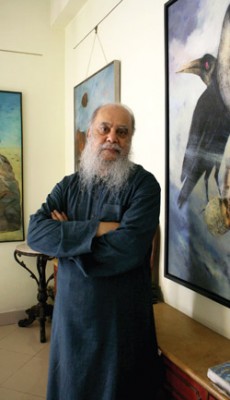SOMETHING ABOUT Shuvaprasanna has always been a democratising force. This is Shuva at age 9. He had been sketching his father’s patients and was considered very accomplished. When he heard that Kliment Voroshilov, the president of erstwhile USSR, was visiting Kolkata, he decided he must sketch him. So he set off at a brisk pace without telling anyone at home. When he reached the Soviet Land office, the gates were closed. But like a child hero of Russian folk tales, he argued his way in and proved his ability by painting the director’s daughter. The next day, to his family’s shock, the boy portraitist was escorted to Raj Bhavan in a big car for sket – ching the visiting dignitary.
Nothing quite in his conservative Brahmin upbringing explains the spark that has kept Shuvaprasanna and his biblical beard in the thick of everything that is going on. Perhaps he comes from a less anodyne time when artists would have been embarrassed to live in an ivory tower. Perhaps it is because he is a midnight’s child, as old as the country. His retrospective is travelling swiftly across the metros having kicked off in the Lalit Kala Akademi. His days are filled with visitors — old friends and the newly curious. Elections are a few weeks away. His very public political association as key adviser to Mamata Banerjee and a campaign for Paribartan Chai (we need change) makes this a heated time.
With a family full of doctors, no one could quite swallow his studying art. His father didn’t speak to him for years because of his vocation and for choosing to marry Shipra Bhattacharya — a well-known artist he could not stomach because she was from another caste. Shuvaprasanna talks about those years with as little self-doubt as he had as a young man. Straight out of art school, he was earning a comfortable living as the illustrator at The Statesman. “I was making Rs 1,200 a month at a time when a schoolteacher made Rs 100. A month after joining, I realised the job meant I couldn’t travel and organise group art shows across the country as I normally did. So, I quit.” Like Wes Anderson’s unforgettable teenage hero Max Fischer, Shuvaprasanna had been organising groups for collective action even as a schoolchild. At 22, he had created the Society for Art and Artists. He was an active part of the Calcutta Artists Group, along with other socially committed artists like Jogen Chowdhury and Nikhil Biswas. Later, there was the College of Visual Art and, decades later, his friendship with writer Gunter Grass led to the creation of a lively art centre — the Arts Acre. Grass deepened his instincts by telling him, “Don’t be an ignorant man. Go and learn about the people.” Shuvaprasanna has never stopped trying. His paintings during the Naxal period were a source of inspiration for filmmaker Mrinal Sen as he made Calcutta 71.
N RECENT YEARS, apart from being at political frontlines, he has tried to start a television channel and serves as the chair of the passenger amenities committee for West Bengal.
And between all this, there is always the painting. Hours and hours of it — starting at 6 am every day — despite all his intrinsic gregariousness. At 65, he jokes he doesn’t mind going everywhere as long as he can eat at home. “If I have to come back and work, I have to avoid being tempted by spreads.” From his vast body of work across media what really stands out is the etchings of animals and birds. He has dedicated a cockle-warming series of crows to Ted Hughes’ eponymous poems. “In Kolkata, you cannot ignore crows. They are like the people of Kolkata. They are clever, jealous, witty and angry. They are survivors.” Shuvaprasanna has made it clear before he may love beauty but not petty prettiness. A Kolkata club refused to let him in because he was wearing a kurta — twice. Years later, he was felicitated at an event held at the same club. He arrived in a lungi, vest and Vidyasagari shoes (curled in front, open at the back). The club swallowed it. At a time when Bengal’s elite shuddered at the ‘roughness’ of Mamata Banerjee — all crumpled cotton sari and plastic chappals — Shuvaprasanna threw his weight behind her. He says without hedging that Bengal’s Left government has to go. “The communists are killing the poor, the farmers and the Adivasis. This is state-sponsored terrorism.”
In the retrospective, Shuvaprasanna’s grim, dark canvasses of human suffering are unsettling, but the Radha Krishna series comes out of the left field. They are sometimes charming but largely on the decorative side. These nonthreatening paintings have sold for as much as Rs 20 lakh, much higher than any of his other work. With his characteristic good nature and lack of dogma, Shuvaprasanna talks about it, “Religion is in my DNA. About 10 years ago, I came across a book about Mahishasura Mardhini. As I read it, I suddenly remembered that my father used to read verses from it aloud. The stories of the devi and her fight with evil made sense to me. And I wanted to paint the ancient myths with a contemporary sensibility. That’s where the colourful paintings of Durga, Radha-Krishna, the golden flute all came from. Those paintings express what I believe — only love can make this world beautiful.”






